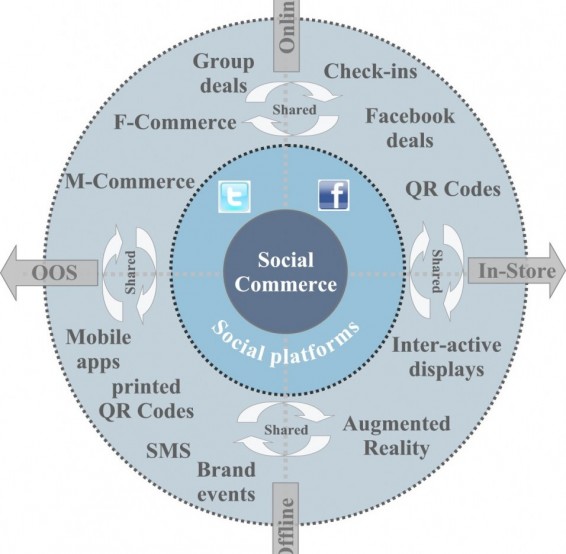De ontwikkeling van mobile en social e-commerce

Smartphones veranderen in toenemende mate de manier we hoe offline handelen. Of het hier nu gaat om het opzoeken van een adres, prijzen of leuke restaurantjes, het is mogelijk, anytime, anywhere. De smartphone is onze toegang tot alle informatie; een van de belangrijkste en meest persoonlijke communicatie tools. Bij social commerce draait het niet alleen om het hebben van een winkel op Facebook, maar om de invloed die social en mobile hebben op onze aankoopbeslissingen.
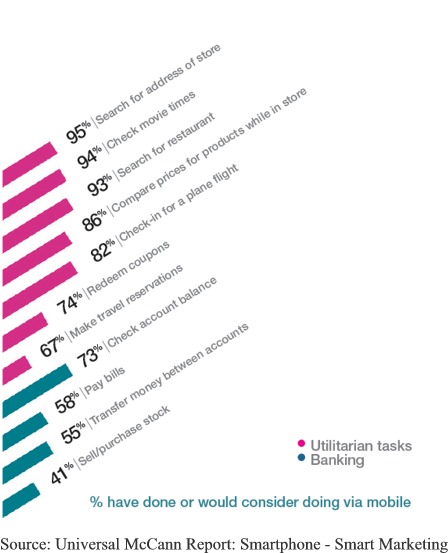
Om deze beweringen met data te staven voegde TribalCafe in deze blog verschillende gegevens samen. Onderzoek van McCann laat zien waarvoor de smartphone allemaal gebruikt wordt. Wat je hiervan kunt opmaken is dat de smartphone voor veel uiteenlopende taken wordt gebruikt, ook mobile banking wordt al veel gebruikt.
De invloed van social commerce is terug te zien in alle facetten van het aankoopproces. Voor de aankoop gaat het bijvoorbeeld om het lezen van reviews en commentaren, bij de point of sale om prijzen en coupons en bij aftersales het delen en beoordelen. Het gaat niet langer om alleen kanalen, social commerce beïnvloedt de gehele customer life cycle. Contact tussen merken en consumenten verloopt daarbij niet op basis van kanalen, maar op basis van “touch points”. Smartphones zijn hierbij de lijm tussen de online en offline wereld.
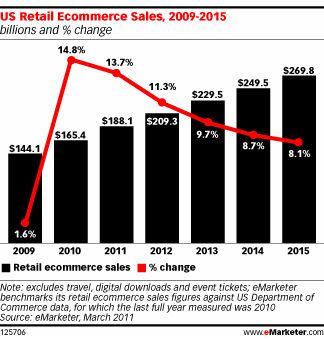
Recente cijfers van eMarketer over de Amerikaanse e-commerce markt laten zien dat in 2009 er 144 miljard dollar is omgezet. De analisten van eMarketer verwachten dat dit zal toenemen tot $270 miljard in 2015. Een flink getal, echter, een nog relatief klein percentage (8%) ten opzichte van de totale markt.
Ook de E-Commerce sales data van comScore laat een stijging zien. In het eerste kwartaal van 2011 is er 12% meer omgezet dan in het voorgaande jaar. In Q1 is er totaal 38 miljard aan e-commerce in de VS omgezet. Dit cijfer ligt lager dan dat van eMarketer, omdat comScore veilingen, auto’s en grote bedrijfsaankopen niet meeneemt.
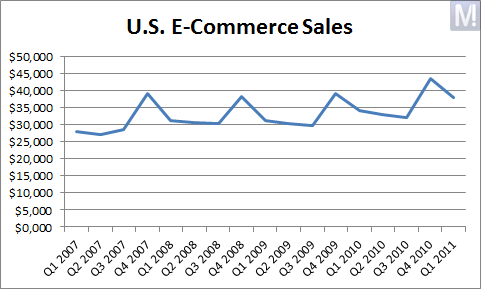
Een van de belangrijkste drijfveren van mobile commerce is Facebook. Op gebied van verdienmodellen zijn zij veel verder dan Twitter. De Open Graph van Facebook beïnvloedt de beoordeling van producten buiten Facebook zelf. Ook Check-In Deals en In-Store shopping experiences hebben hierop invloed. Ook binnen Facebook is social en mobile commerce terug te zien in Facebook Credits, native Facebook winkels en Facebook Deals.
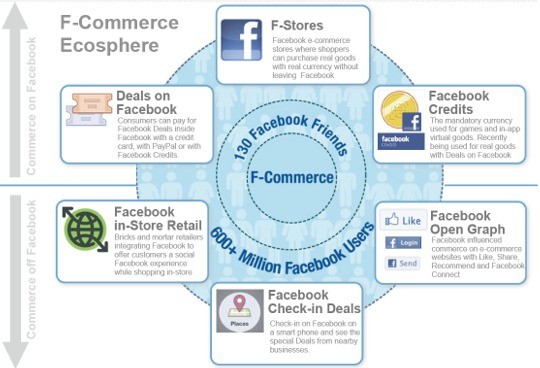
Het voordeel van Facebook is dat zij zeer veel kennis hebben van de gebruikers. Facebook weet van haar klanten de persoonlijke informatie, het persoonlijk netwerk, transacties en locaties. Deze data inzetten om de winkelervaring te verbeteren biedt gigantische mogelijkheden.
Bouwstenen
Bij TribalCafe hebben ze het volgende stappenplan beschreven. Ze bevelen bedrijven aan om klein te beginnen met enkele experimenten en die constant aan te passen tot ze een idee hebben wat goed werkt. Bedrijven die dit omarmen zouden zo profiteren van lagere acquisitiekosten, servicekosten en een snellere time to market.
1. Integration
Get your channels in place. Set up Facebook and Twitter profiles – these are the main players.
Develop a mobile website, this is increasingly important and most websites do not render or work effectively on a mobile.
Use your mobile website to offer promotions, QR codes…many mobile website solutions like ours allow you to control this through a Content Management System that is easy to use.
‘Socialise’ your website: add social media sharing links to your website.
Make it easy for people to share integrate social sharing with social sign-on so that items can be shared with the least amount of friction.
2. Facebook Page
Develop your Facebook page and build you fan page. If you haven’t established a Facebook page yet then don’t just rush in and commission a Facebook store you need to initially test and build you presence on Facebook, make sure it works for you.
Commission a branded landing page. Actively promote your products, promotions and discounts using email, Twitter and Facebook.
Understand how social your customers are: listen and engage customers to see how they react. Social is not for everyone.
3. Extend your capabilities
Enable sharing with friends before buying – to allow customers to crowd/friend-source advice on whether to buy.
Use a Social Shopping Cart which allows people to shop and share with their friends via Facebooks social graph.
Integrate Facebook comments into products; customer feedback is the essence of improving your range and products
Don’t just sell: social commerce shouldn’t be all about selling – add value to their customers’ shopping experience – and give them a reason for communicating with you and their peers.
Create a dialogue with customers who want to talk to you. Use your blog and social channels to do this.
Use your Facebook wall like it’s your shop window but don’t only broad cast – use it for feedback. Openly encourage customers to have a say in the business – by crowdsourcing decisions it will encourage how they promote you (word of mouth initiatives)
Integrate your customer service strategy with your social media strategy – diffuse situations by helping customers directly through social media.
4. A Facebook Store
Investigate bespoke solutions turn your Facebook account into a fully functional e-commerce platform.
Use Facebook contests that request “Likes” to automatically send users to the Facebook store to encourage product browsing.
Integrate your marketing and inform your current customers where to find your store and how it works.
Use the Facebook Fans API to combine promotions with links to product detail and purchase pages within the Facebook store – this enables brands to collect profile data. Add product videos – and host them on YouTube.
5. Promotions
Have a clear strategy and timetable promotions, make it varied and keep It interesting.
Don’t simply discount. Use virtual rewards as well as monetary ones – reward your fans with exclusive discounts and promotions.
Form alliances or partnerships with local businesses where you have synergies to promote each other.
6. Measure
It is important to use a number of different tactics to drive traffic to your website, develop referrals from social media and use offline tactics.
Measure and track how effective each is and use the information to refine and improve your marketing.
Use Facebook analytics to understand who is buying, who is being converted – use it to refine your marketing approach.
Touch points
Vervolgens presenteren ze een grf model waarin het de touch points en technologie integreert. Het is niet zozeer een model als wel een voorbeeld van hoe mobile, social en opkomende technologiën en rol spelen voor bedrijven.
